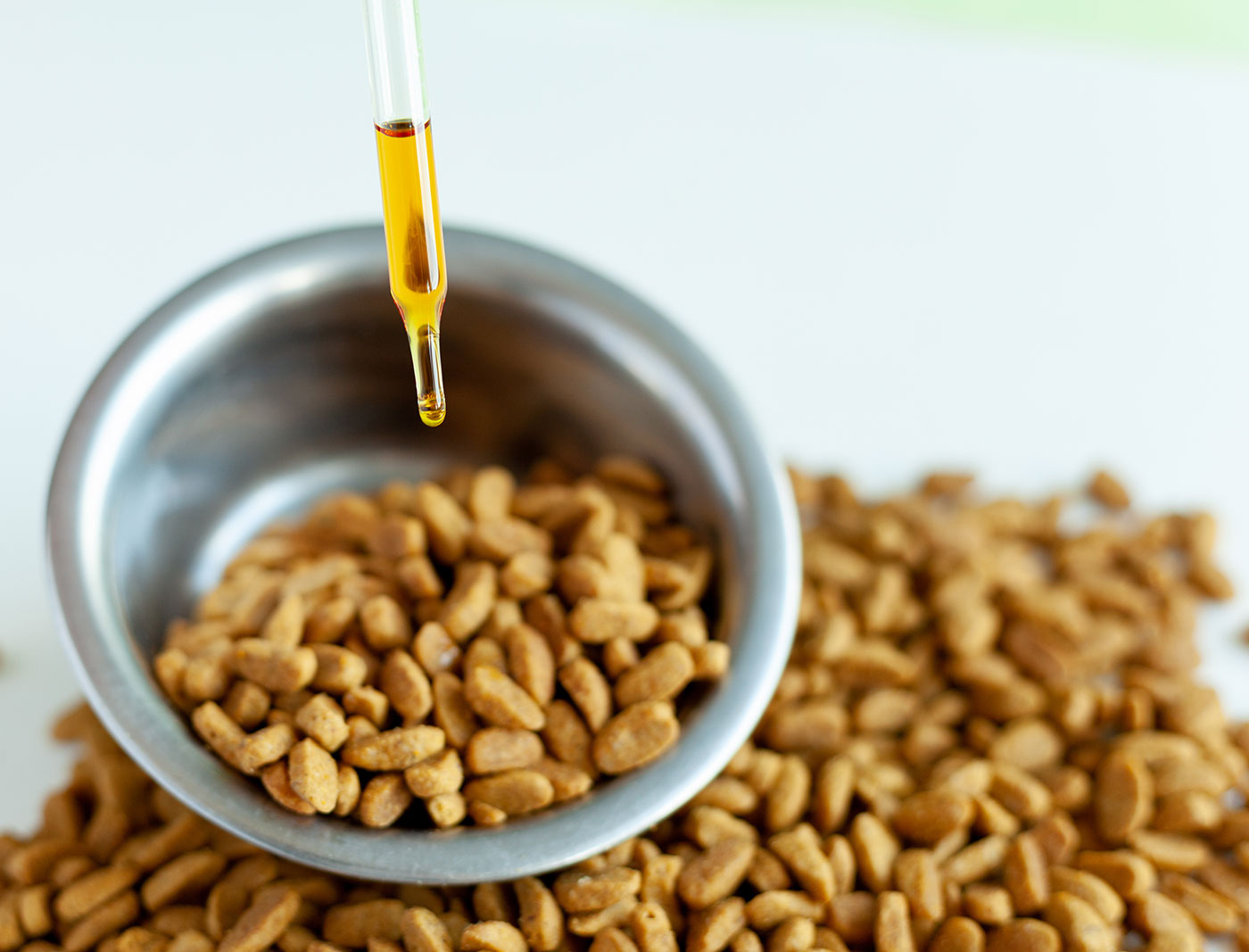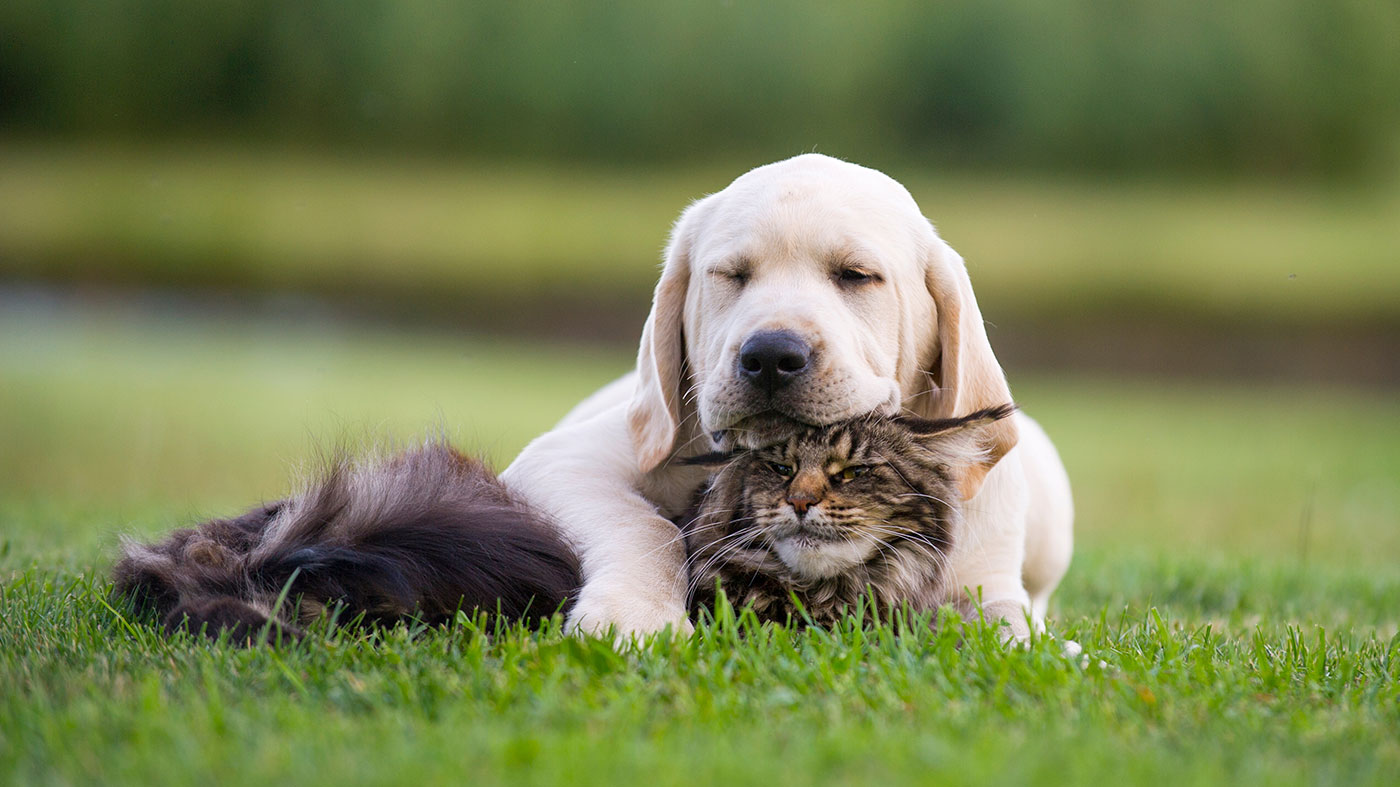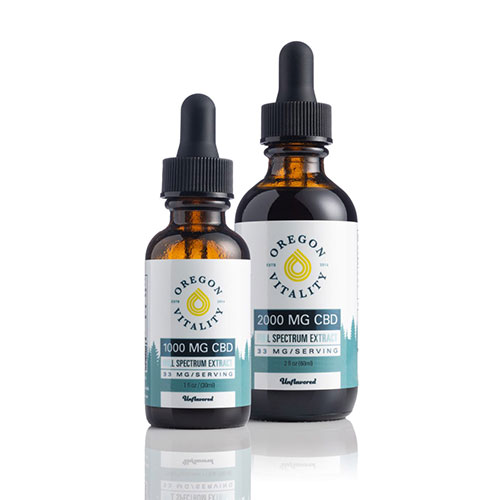How to Dose CBD for Pets
Written by JC Riggs and Jennifer Hooson
Are you considering using a CBD product like our Full Spectrum Tinctures or Pure CBD Isolate Tinctures (THC-Free) on your pet? Have you heard all of the buzz about how it can help your animal with their joint pain, inflammation, and upset stomachs? That is fantastic! CBD products have been shown to be very beneficial in helping animals feel better. However, it is very important to do it in a safe manner. As always, we recommend you speak with your pet’s veterinarian prior to using CBD on any of your animals. With that in mind, you will find our recommendations on how to share the benefits of CBD with your pet below.
Since CBD is best metabolized by the body when there is fat taken with it, researchers have found it is best to give animals their CBD with food2,11. Veterinary professionals and pet owners alike can attest that canned food is nearly always a favorite. Therefore, we recommend that you mix their dose with a small amount of food. One good mouthful should be enough. Once they eat all of it, then you can give them the rest of their breakfast or dinner. It is important that you give them a dose in the morning and at night. This is because of how long the majority of the CBD stays in the animal’s system and the biphasic nature of CBD metabolism 5, 9. This method ensures your pet is getting their full dose with the maximum amount of absorption11.
The Starting/Low Dose should be given for the first 10-14 days to allow your pet to get used to the CBD and for their bodies to build up therapeutic levels in their tissues11. If you are getting the desired effect from the starting/low dose, you can continue your pet on it. If needed, you can increase up to the full dose level, but be sure to do so incrementally over a few weeks so your pet’s body can adjust. And be sure to stop once you find the dose that works best for your animal. Be aware that some pets who are obese or have more sever conditions may need a higher dose10, 11,12.
Once your pet has been on the effective dose for 30 days, you may be able to lower it slowly until you find the lowest dose that will still have the desired effect for your animal10. This will be animal dependent. Some animals may even seem to no longer have the desired effect on their regular dose. If this happens you can take them off of the CBD for a few days to allow their bodies to reacclimate and then start them back on their regular dose. This usually will bring back the desired effect10.
Our doses are based on research by Dr. Silver, an expert in the field of holistic veterinary medicine from Colorado, and the veterinary professionals at VetCS.com. From the information they provide in their veterinary professional continuing education courses as well as our own research into the field of veterinary use of CBD, we are confident that our doses are well within the safety range for animals. Still, we ask that you remember, every animal is different so be sure to consult your pet’s veterinarian and observe your pet closely while you transition them onto a CBD product.

*NOTE: The following dosages are based on Oregon Vitality droppers specifically.
Shake the bottle well every time before drawing up dose
Full Spectrum Tinctures: (Concentration: 0.66 mg CBD/drop, 50 drops/ml)
Starting/low Dose: Twice a Day
(pets 5+lbs only, dose 0.1mg/kg, for a 50lb dog a 2oz bottle will last ~16 months):
5-29 lbs 1 drop
30-49 lbs 2 drops
50-59 lbs 3 drops
60-79 lbs 4 drops
80-89 lbs 5 drops
90-109 lbs 6 drops
110-119 lbs 7 drops
120-149 lbs 8 drops
150-174 lbs 10 drops
175-199 lbs 12 drops (~¼ ml)
200+lbs 13 drops
Normal Dose: Twice a Day
(pets 5+lbs only, dose 0.5mg/kg, for a 50lb dog a 2oz bottle will last ~2.5 months):
5-9 lbs 1 drop
10-14 lbs 3 drops
15-19 lbs 5 drops
20-24 lbs 6 drops
25-29 lbs 8 drops
30-34 lbs 10 drops
35-39 lbs 12 drops (~¼ ml)
40-49 lbs 13 drops
50-59 lbs 17 drops
60-69 lbs 20 drops
70-79 lbs 24 drops (~½ ml)
80-89 lbs 27 drops
90-99 lbs 30 drops
100-109 lbs 34 drops
110-119 lbs 37 drops
120-129 lbs 41 drops
130-149 lbs 44 drops
150-174 lbs 51 drops (1ml +1 drop)
175-199 lbs 1ml + 10 drops
200+lbs 1ml +18 drops
Safety studies have shown that pets given up to 10 times as much CBD were still relatively safe3,6,8. So, while we do not recommend such high doses, it will hopefully help you feel more comfortable knowing these doses are well within the safety range.
Keep in mind that our Full Spectrum products do contain a small amount of THC while our Pure CBD Isolate Tinctures are THC-Free. When you use the Full Spectrum products you are allowing your pet to get the same entourage effect from all of the cannabinoids, flavonoids, and terpenes working together on their endocannabinoid system as what you would get using the same product. However, some animals are hyper sensitive to THC and therefore it is extremely important that you speak with your pet’s veterinarian and observe your animal closely. If you have concerns or a reason to believe your pet may be sensitive to THC then our THC-Free tinctures are a great option for you. Please note that they work very well, and because they do not take advantage of the entourage effect by including all of the components of the hemp plant you will need to give a higher dose9.
Shake the bottle well every time before drawing up dose
Pure CBD Isolate Tinctures (THC-Free): (Concentration: 0.66 mg CBD/drop, 50 drops/ml)
Starting/low Dose: (pets 5+lbs only, dose 1mg/kg, for a 50lb dog a 1oz bottle will last~1.5 months):
3 drops for every 5 lbs, twice a day
Normal Dose: (pets 5+lbs only, dose 2mg/kg, for a 50lb dog a 1oz bottle will last ~25 days):
6 drops for every 5 lbs, twice a day
Some side effects to be aware of8, 12:
Soft Stools, Tiredness, Hyperactivity, Licking, Chewing, Salvation, Hypothermia, Head Shaking, Raised Nictating Membranes (3rd eyelid protrusion). Most adverse effects came and went and do not require medical treatment. However, always seek advice from your pet’s veterinarian if you are concerned or an issue persists.

If you choose to use our Salve just be sure to not allow your pet to lick the area and ensure that it gets applied down to the skin level so it can get absorbed. There is not as much concern about THC in the salve because it has a much harder time absorbing through the skin, however they can still ingest it if they lick it off.
CBD in topical applications has great antimicrobial properties. They are effective against many forms of bacteria, fungus, and some viruses 1, 4,7. Consult with your pet’s veterinarian if you think one of these options might be a good option for your pet with problematic skin conditions.
We hope all of this information has helped you gain a better understanding of how to dose your dog or cat with a CBD product. Please do not hesitate to contact us with any questions or speak directly to your pet’s veterinarian.
Sources:
- Aqawi, M., Sionov, R., Gallily, R., Friedman, M., & Steinberg, D. (2021). Anti-Bacterial Properties of Cannabigerol Toward Streptococcus mutans. Frontiers In Microbiology, 12. doi: 10.3389/fmicb.2021.656471
- Bartner, L., McGrath, S., Rao, S., Hyatt, L., & Wittenburg, L. (2018). Pharmacokinetics of cannabidiol administered by 3 delivery methods at 2 different dosages to healthy dogs. Canadian Journal Of Veterinary Research, 82(3), 178-183(6).
- Deabold, K., Schwark, W., Wolf, L., & Wakshlag, J. (2019). Single-Dose Pharmacokinetics and Preliminary Safety Assessment with Use of CBD-Rich Hemp Nutraceutical in Healthy Dogs and Cats. Animals, 9(10), 832. doi: 10.3390/ani9100832
- Feldman, M., Sionov, R., Mechoulam, R., & Steinberg, D. (2021). Anti-Biofilm Activity of Cannabidiol against Candida albicans. Microorganisms, 9(2), 441. doi: 10.3390/microorganisms9020441
- Gallily, R., et al. (2015). Overcoming the bell-shaped dose-response of cannabidiol by using cannabis extract enriched in cannabidiol.
https://file.scirp.org/pdf/PP_2015021016351567.pd - Gamble, L., Boesch, J., Frye, C., Schwark, W., Mann, S., & Wolfe, L. et al. (2018). Pharmacokinetics, Safety, and Clinical Efficacy of Cannabidiol Treatment in Osteoarthritic Dogs. Frontiers In Veterinary Science, 5. doi: 10.3389/fvets.2018.00165
- Klahn, P. (2020). Cannabinoids-Promising Antimicrobial Drugs or Intoxicants with Benefits?. Antibiotics, 9(6), 297. doi: 10.3390/antibiotics9060297
- Kulpa, J.E. et al. (2021) “Safety and tolerability of escalating cannabinoid doses in Healthy Cats,” Journal of Feline Medicine and Surgery, 23(12), pp. 1162–1175. Available at: https://doi.org/10.1177/1098612×211004215.
- Lee, M. (2015). Single Compound vs. Whole Plant CBD. Retrieved 18 November 2021, from https://www.projectcbd.org/science/pure-cbd-better
- Luedke, C. (2022). In Colorado Association of Certified Veterinary Technicians: Spring Conference. CACVT.
- Silver, R. (2020). Veterinary CBD: What does the evidence say? A review of the studies. Presentation, Online.
- Vaughn, D., Kulpa, J., & Paulionis, L. (2020). Preliminary Investigation of the Safety of Escalating Cannabinoid Doses in Healthy Dogs. Frontiers In Veterinary Science, 7. doi: 10.3389/fvets.2020.00051
You might also be interested in
Does THC make a difference? Learn about Full Spectrum vs CBD Only
Does THC make a difference? Learn About Full Spectrum vs CBD Only:Written by JC Riggs and Jennifer HoosonCannabidiol (CBD) products are taking off...
Huge Discounts for Heroes: Oregon Vitality’s Heroes Program
Written by Jennifer Hooson | Reviewed by JC Riggs Who is a hero to you? What does it mean to be a hero? For us, heroes are those who look each day...
3 Ways Hemp Helps The Environment Heal
Hemp (Cannabis sp.) is known for its utility when it comes to recreational/commercial products, specifically CBD, but did you know that it is also...






